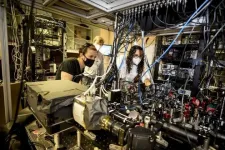RIXS demonstrates magnetic behaviour in nickelate superconductors
New findings in a new material bring us closer to understanding superconductivity
2021-07-09
(Press-News.org) The discovery of the first high-temperature superconductor in 1986 brought with it the hope that superconductivity would one day revolutionise power transmission, electronic devices and other technologies. Materials that show superconductivity (zero electrical resistance) generally do so at an extremely low temperature. For their use to become widespread and world-changing, we need to develop a material that is superconducting close to room temperature. Research showed that the first high-temperature superconductor - a copper oxide compound - was part of a family of materials known as cuprates. Scientists have found cuprates that are superconducting at temperatures as high as 133.5 K. However, we don't fully understand how superconductivity arises in the high temperature superconductors. In 2019, the discovery of superconductivity in a nickel oxide compound opened up new avenues of research. Scientists can now compare this nickelate material to cuprates to discover the similarities and differences. In a study recently published in?Science, researchers at Diamond, SLAC, Stanford University, and Leiden University, used Resonant Inelastic X-ray Scattering (RIXS) to study the magnetic properties of the nickelate superconductor. Their results shed light on the underlying physics that gives rise to superconductivity.
Compare and Contrast
The discovery of superconductivity in a second family of materials offers the opportunity to assess their similarities and differences and could bring us closer to understanding how high-temperature superconductivity arises.
For superconductivity to occur, electrons that normally repel each other (due to their identical charge) have to become attractive. Electrons pair up, and at a low enough temperature (the critical temperature for the material, Tc), they condense to form a superfluid that flows without friction. Zero electrical resistance is the result. Copper oxides are antiferromagnetic, whose spins align in a regular pattern with neighboring spins pointing in opposite directions forming long-range order. One theory as to why zero resistance in cuprates is that the residual spin fluctuations of the moving electrons may cause them pair up.
In 2019, researchers from Stanford and the SLAC overcame considerable challenges to produce the nickelate Nd0.8Sr0.2NiO2 and found that it is superconducting at around 9-15 K. The nickelate material has a crystal structure similar to that of cuprates, but would its electrons behave in the same way?
These superconducting materials are prepared as thin nickel or copper oxide sheets sandwiched between layers of other elements, such as rare-earth ions. These are "doped", adjusting the density of free-flowing electrons. Before being doped, cuprate materials are insulators with electrons that do not move around. After doping, the electrons move freely in their cuprate layers, rarely travelling into the rare-earth layers.
In work published in Nature Materials in 2020, studies carried out on Diamond's I21 beamline showed that the electron behaviour in nickelates is very different. An undoped nickelate is a metallic material with free-flowing electrons that move between layers, creating a 3D metallic state.
A magnetic mystery
Another interesting facet of the superconductor conundrum is that - so far - the nickelates do not show the same kind of magnetic order seen in cuprates. To investigate further, it was back to the RIXS beamline.
Principal beamline scientist Ke-Jin Zhou explains: "RIXS is the only technique powerful enough to analyse the tiny magnetic signals coming from the nickelate sample. It's a minute sample, a tiny volume of the material, and I21 has the most advanced RIXS instrument in the world. We achieved spectacular results. I was amazed that the entire spectrum from the nickelate is so similar to that of a cuprate in terms of magnetic fluctuation. This is the first experimental confirmation of magnetic behaviour in the nickelate superconductor."
These results shed some light on the mechanisms underlying superconductivity. They bring us one step closer to the day we can develop a room-temperature superconductor and explore the many benefits of these remarkable materials.
INFORMATION:
To find out more about the I21 beamline or discuss potential applications, please contact Ke-Jin Zhou:?kejin.zhou@diamond.ac.uk.
[Attachments] See images for this press release:

ELSE PRESS RELEASES FROM THIS DATE:
2021-07-09
Anyone who likes to sing in the shower probably knows that they sometimes sing out of tune. But what about professional singers? How well do they evaluate their own abilities? And what role does this self-assessment play in becoming a better musician? A research team from the Max Planck Institute for Empirical Aesthetics in Frankfurt, New York University, and the University of Hamburg has now investigated these questions scientifically in a study of professional singers.
The study participants, all female sopranos, were each recorded singing "Happy Birthday" in a studio. They were then asked to listen to all of the recordings and rate the pitch accuracy of both their ...
2021-07-09
Babies younger than four weeks old, called neonates, were once thought not to perceive pain due to not-yet-fully-developed sensory systems, but modern research says otherwise, according to researchers from Hiroshima University in Japan.
Not only do babies experience pain, but the various levels can be standardized to help nurses recognize and respond to the babies' cues -- if the nurses have the opportunity to learn the scoring tools and skills needed to react appropriately. With tight schedules and limited in-person courses available, the researchers theorized, virtual e-learning may be able to provide a path forward for nurses to independently pursue training in this area.
To test this hypothesis, researchers conducted a pilot study ...
2021-07-09
Drs. Nobuo Noda (Director) and Tatsuro Maruyama (Researcher) et al. at the Institute of Microbial Chemistry (BIKAKEN, Tokyo, Japan) discovered that lipidated Atg8(1), the most famous factor that mediates autophagy, has membrane perturbation activity and elucidated that this activity is responsible for efficient autophagosome formation.
Autophagosome formation is an essential step in determining the target of degradation in autophagy, which is one of the mechanisms of intracellular protein degradation. It is known that lipidated Atg8 plays a primary role in autophagy processes; however, the molecular function of lipidated Atg8 on the autophagy-related ...
2021-07-09
A new study from Queen Mary University of London has demonstrated that immune cells can be stimulated to assemble into special structures within pancreatic cancer such that, at least in a pre-clinical model, researchers can demonstrate an improvement in the efficacy of chemotherapy.
The body's immune system is a critical defence against illness such as infections, as has been highlighted by the recent COVID-19 pandemic. The same immune system can also help us fight cancer. However, pancreatic cancer is different; a key feature of this cancer type is that the pancreatic cancer cells are surrounded by a dense, impenetrable barrier known as the stroma, which often blocks the access of immune cells to ...
2021-07-09
Coral reefs are a favorite spot for scuba divers and are among the world's most diverse ecosystems. For example, the Hawaiian coral reefs, known as the "rainforests of the sea," host over 7,000 species of marine animals, fishes, birds and plants. But coral reefs are facing serious threats, including a number of diseases that have been linked to human activity.
To understand the connection between human activity and a type of tumorlike disease called growth anomalies (GAs), researchers at the National Institute of Standards and Technology (NIST) have collaborated with the U.S Geological Survey (USGS) and the National ...
2021-07-09
ATLANTA--The American College of Rheumatology (ACR), in partnership with the Vasculitis Foundation (VF), released three new guidelines for the treatment and management of systemic vasculitis. Vasculitis is a group of about 20 rare diseases that have inflammation of blood vessels in common, which can restrict blood flow and damage vital organs. The three guidelines cover six forms of vasculitis, and a fourth guideline on Kawasaki disease will be released in the coming weeks.
"Many rheumatologists may have limited experience caring for patients with these diseases," ...
2021-07-09
Strokes, which occur when the blood supply to part of our brain is interrupted or reduced, are the leading cause of death and disability in the adult population. Among the patients who survive, 75% will experience difficulties carrying out daily activities independently and need long-term functional exercises and rehabilitation. But the outcomes using traditional rehabilitation equipment are poor. In addition, the motivation of patients to train is often low.
The Department of Neurology in Tongji Hospital, which is affiliated to Tongji Medical College at the Huazhong University of Science and Technology, is recognised in China for the quality of its scientific research and clinical strength. Similarly, Zhejiang BrainCo, Ltd., incubated by the Harvard Innovation Lab, is a market ...
2021-07-09
Contrary to conventional thought, songbirds can taste sugar--even though songbirds are the descendants of meat-eating dinosaurs and are missing a key protein that allows humans and many other animals to taste sweetness. An international team investigated how many bird species can taste sweet and how far back that ability evolved. Their work was published today in the journal Science.
The researchers offered two species of songbirds a choice between sugar water and plain water--nectar-taking honeyeaters, as well as canaries, a grain-eating bird not known for consuming sweet foods. They also examined taste receptor responses sampled from a variety of other species. Regardless of whether their main ...
2021-07-09
A team of physicists from the Harvard-MIT Center for Ultracold Atoms and other universities has developed a special type of quantum computer known as a programmable quantum simulator capable of operating with 256 quantum bits, or "qubits."
The system marks a major step toward building large-scale quantum machines that could be used to shed light on a host of complex quantum processes and eventually help bring about real-world breakthroughs in material science, communication technologies, finance, and many other fields, overcoming research hurdles that are beyond the capabilities of even the fastest supercomputers today. Qubits are the fundamental building blocks on which quantum computers ...
2021-07-09
How does unicellular life transition to multicellular life? The research team of Professor Lutz Becks at the Limnological Institute of the University of Konstanz has taken a major step forward in explaining this very complex process. They were able to demonstrate - in collaboration with a colleague from the Alfred Wegner Institute (AWI) - that the unicellular green algae Chlamydomonas reinhardtii, over only 500 generations, develops mutations that provide the first step towards multicellular life. This experimentally confirmed a theory on the origin of multicellular life, which says that the evolution of cell groups and the subsequent steps towards multicellularity can only take place when cell groups are both better at reproduction and more likely to survive than single cells. ...
LAST 30 PRESS RELEASES:
[Press-News.org] RIXS demonstrates magnetic behaviour in nickelate superconductors
New findings in a new material bring us closer to understanding superconductivity





